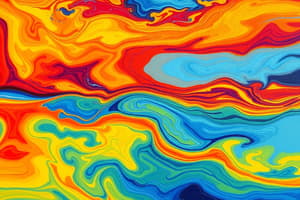Podcast
Questions and Answers
What does SST stand for?
What does SST stand for?
- Surface Sea Trend
- Sea Stream Temperature
- Sea Surface Temperature (correct)
- Surface Salinity Temperature
SST measurements are only conducted through satellite technology.
SST measurements are only conducted through satellite technology.
False (B)
Name two factors that SST affects concerning weather patterns.
Name two factors that SST affects concerning weather patterns.
Intensity and frequency of storms
SST data is important for predicting ___________ and understanding their effects on coastal environments.
SST data is important for predicting ___________ and understanding their effects on coastal environments.
Which of the following is a method used to measure SST?
Which of the following is a method used to measure SST?
Match the SST-related concepts with their descriptions:
Match the SST-related concepts with their descriptions:
What impact can changes in SST have on marine ecosystems?
What impact can changes in SST have on marine ecosystems?
SST has no effect on human societies.
SST has no effect on human societies.
Flashcards
What is SST?
What is SST?
The temperature of the ocean's surface, a crucial factor in climate and marine life.
How is SST measured?
How is SST measured?
SST is measured using various methods, including satellites and in situ instruments (e.g., buoys, ships).
How does SST impact climate?
How does SST impact climate?
SST plays a critical role in regulating global climate patterns, influencing weather systems like storms and affecting global temperature distributions.
How does SST affect marine life?
How does SST affect marine life?
Signup and view all the flashcards
What are some applications of SST data?
What are some applications of SST data?
Signup and view all the flashcards
What are some impacts of SST variations?
What are some impacts of SST variations?
Signup and view all the flashcards
Where can I find SST data?
Where can I find SST data?
Signup and view all the flashcards
Why is SST data important?
Why is SST data important?
Signup and view all the flashcards
Study Notes
Definitions and Concepts
- SST stands for Sea Surface Temperature.
- It is the temperature of the water at the ocean's surface.
- SST is a crucial factor in many climate phenomena and oceanographic processes, impacting weather patterns, marine life and even human societies.
Measurement Techniques
- SST is measured using various methods, primarily by satellites and in situ instruments (e.g., buoys, ships).
- Satellite-based measurements are often used for large-scale monitoring of global SST patterns, providing comprehensive, synoptic views.
- In situ measurements provide valuable high-resolution data in specific locations and time periods, often crucial for validating satellite data and studying localized phenomena or impacts on marine life.
- Different types of sensors are used, including infrared (IR) sensors and microwave radiometers.
Importance in Climate Studies
- SST plays a critical role in regulating global climate patterns and influencing weather systems.
- It affects the intensity and frequency of storms, such as hurricanes and typhoons.
- Heat transport by ocean currents through SST significantly impacts global temperature distributions.
- Variations in SST can lead to climate anomalies, such as El Niño and La Niña events.
Relationship with Marine Life
- SST greatly influences the distribution and abundance of marine life.
- Different species of phytoplankton and zooplankton thrive in specific temperature ranges.
- Fish and other marine animals have temperature tolerances that influence their migration patterns and breeding cycles.
- Changes in SST can disrupt marine ecosystems and cause large-scale shifts in species distribution.
Applications in Various Fields
- SST data is used in various fields, including marine biology, fisheries management, and climate modeling.
- Accurate SST data is vital for predicting ocean currents and understanding their effects on coastal environments.
- The information is used in weather forecasting, especially for tropical storms.
- SST data also aids in understanding and monitoring ocean acidification and deoxygenation.
Data Sources and Accessibility
- Various sources provide access to SST data, including satellite databases and oceanographic institutions.
- Online tools and platforms facilitate the visualization and analysis of SST data.
- Researchers and government agencies rely on this readily accessible data for many research purposes.
Global Variations and Trends
- Global SST displays significant variations across different regions and seasons.
- Long-term trends in SST show a warming trend, largely due to human-induced climate change.
- These changes impact sea level rise and alter weather patterns in various parts of the world.
- Localized variations in SST, such as upwelling events, provide unique insights into ocean processes.
Impacts on Human Activities
- SST changes influence coastal livelihoods through impacts on fisheries and tourism.
- Changes in SST affect extreme weather events, impacting infrastructure and human safety and well-being.
- Understanding and predicting SST changes are crucial for developing adaptation strategies for communities.
Studying That Suits You
Use AI to generate personalized quizzes and flashcards to suit your learning preferences.




